
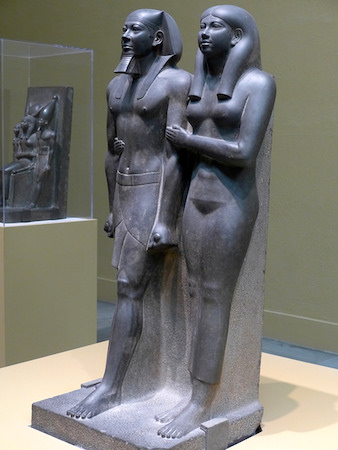
King
Menkaure
(Mycerinus) and queen,
2490–2472 B.C.E.,
greywacke, 142.2 x 57.1 x 55.2 cm
(Museum of Fine Arts, Boston)
(CC BY-NC 2.0)Serene ethereal beauty,
raw royal power, and evidence of artistic virtuosity have rarely been simultaneously captured as well as in this breathtaking, nearly life-size statue of the pharaoh Menkaure and a queen.
Smooth as silk, the meticulously finished surface of the dark stone captures the physical ideals of the time and creates a sense of eternity and immortality even today.
Undoubtedly, the most iconic structures from Ancient Egypt are the massive and enigmatic Great Pyramids that stand on a natural stone shelf, now known as the Giza plateau, on the south-western edge of modern Cairo. The three primary pyramids at Giza were constructed during the height of a period known as the Old Kingdom and served as burial places, memorials, and places of worship for a series of deceased rulers--the largest belonging to King Khufu, the middle to his son Khafre, and the smallest of the three to Khufu's grandson, Menkaure.
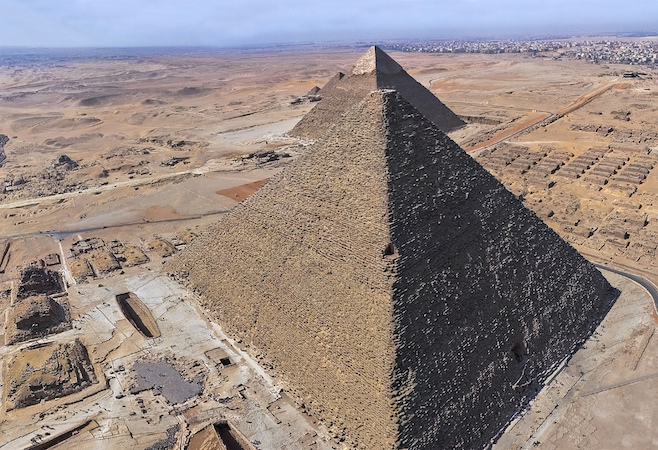 Giza plateau
Giza plateau
(CC BY-NC-SA 2.0)
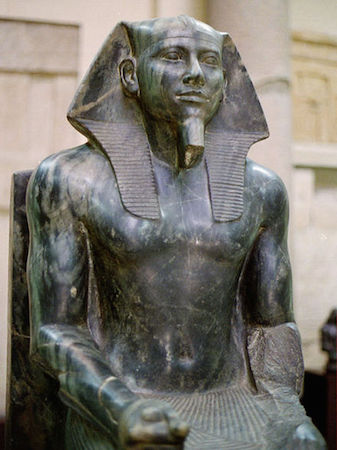
Head and torso (detail),
Khafre enthroned, from Giza,
Egypt,
c. 2520-2494 B.C.E.,
diorite. 5’ 6 inches high
(Egyptian Museum, Cairo)
Pyramids are not stand-alone structures
. Those at Giza formed only a part of a much larger complex that included a temple at the base of the pyramid itself, long causeways and corridors
, small subsidiary pyramids, and a second temple (known as a valley temple)
some distance from the pyramid
. These Valley Temples were used to perpetuate the cult of the deceased king and were active places of worship for hundreds of years
(sometimes much longer) after the king’s death.
Images of the king were placed in these temples to serve as a focus for worship—several such images have been found in these contexts, including the magnificent seated statue of Khafre
, now in the Egyptian Museum in Cairo.
On January 10, 1910, excavators under the direction of George Reisner, head of the joint Harvard University-Museum of Fine Arts
, Boston, Expedition to Egypt, uncovered an astonishing collection of statuary in the Valley Temple connected to the Pyramid of Menkaure.
Menkaure’s pyramid had been explored in the 1830s (using dynamite, no less).
His carved granite sarcophagus was removed
(and subsequently lost at sea),
and while the Pyramid Temple at the base was in only mediocre condition;
the Valley Temple,
was—happily—basically ignored.
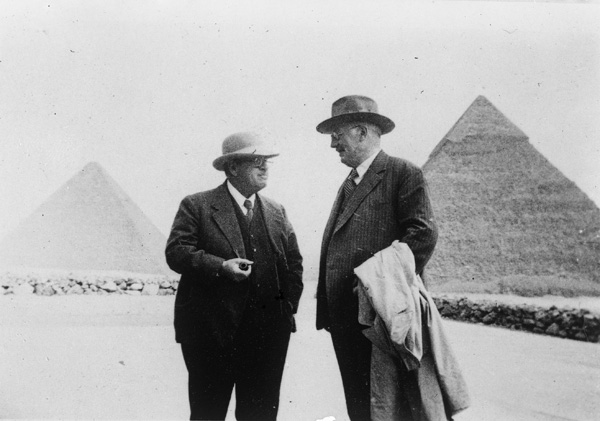 George Reisner and Georg Steindorff at Harvard Camp,
George Reisner and Georg Steindorff at Harvard Camp,
looking east toward Khufu and Khafre pyramids, 1935, photo by Albert Morton Lythgoe
Reisner had been excavating on the Giza plateau for several years at this point
; his team had already explored the elite cemetery to the west of the Great Pyramid of Khufu before turning their attention to the Menkaure complex, most particularly the barely-touched Valley Temple.
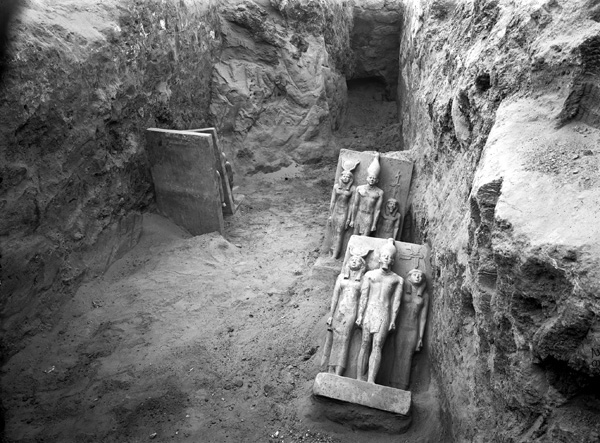 Four greywacke triads
Four greywacke triads
, Menkaure valley temple,
S magazines,
corridor III 4,
photo: 1908 (The Giza Archives).
View one of the triads
, Boston.
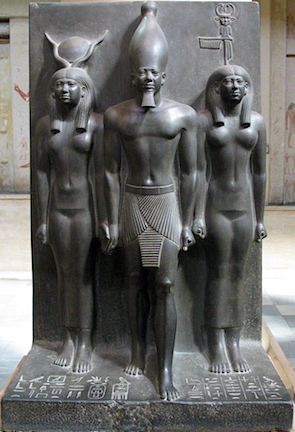
Menkaure flanked by Hathor (left) and nome goddess (Egyptian Museum, Cairo)
In the southwest corner of the structure, the team discovered a magnificent cache of statuary carved in a smooth-grained dark stone called greywacke or schist. There were a number of triad statues—each showing 3 figures—the king, the fundamentally important goddess Hathor, and the personification of a nome
(a geographic designation, similar to the modern idea of a region, district, or county)
. Hathor was worshipped in the pyramid temple complexes along with the supreme sun god Re and the god Horus, who was represented by the living king
. The goddess’s name is actually ‘Hwt-hor’, which means “The House of Horus,” and she was connected to the wife of the living king and the mother of the future king. Hathor was also a fierce protector who guarded her father Re; as an "Eye of Re"
(the title assigned to a group of dangerous goddesses), she could embody the intense heat of the sun and use that blazing fire to destroy his enemies.
There were 4 complete triads
, one incomplete, and at least one other in a fragmentary condition.
The precise meaning of these triads is uncertain. Reisner believed that there was one for each ancient Egyptian nome
, meaning there would have originally been more than thirty of them. More recent scholarship,
however
, suggests that there were originally 8 triads,
each connected with a major site associated with the cult of Hathor. Hathor’s prominence in the triads (she actually takes the central position in one of the sculptures) and her singular importance to kingship lends weight to this theory.
In addition to the triads, Reisner’s team also revealed the extraordinary dyad statue of Menkaure and a queen that is breathtakingly singular.
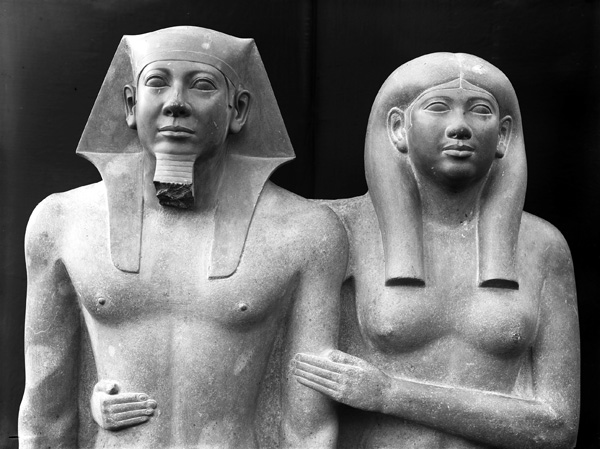 Heads and torsos
Heads and torsos
(detail)
King Menkaure
(Mycerinus) and queen
2490–2472 B.C.E., greywacke
142.2 x 57.1 x 55.2 cm
(Museum of Fine Arts, Boston)
photo: 1910
(The Giza Archives)
The two figures stand side-by-side on a simple, squared base and are supported by a shared back pillar. They both face to the front
, although Menkaure’s head is noticeably turned to his right—this image was likely originally positioned within an architectural niche, making it appear as though they were emerging from the structure. The broad-shouldered, youthful body of the king is covered only with a traditional short pleated kilt, known as a shendjet, and his head sports the primary pharaonic insignia of the iconic striped nemes headdress (so well known from the mask of Tutankhamun) and an artificial royal beard. In his clenched fists, held straight down at his sides, Menkaure grasps ritual cloth rolls. His body is straight, strong, and eternally youthful with no signs of age. His facial features are remarkably individualized with prominent eyes, a fleshy nose, rounded cheeks, and full mouth with protruding lower lip.
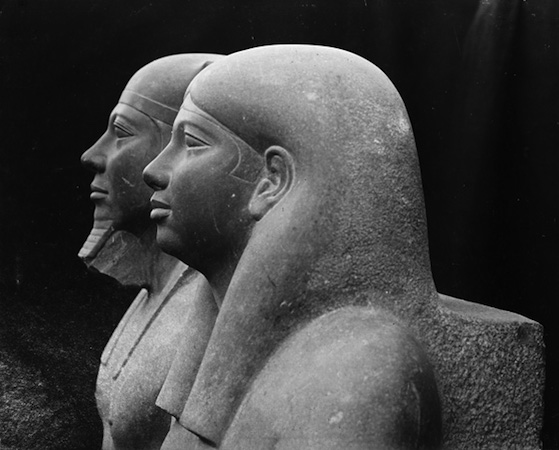 Heads (detail), King Menkaure (Mycerinus) and queen, 2490–2472 B.C.E., greywacke, 142.2 x 57.1 x 55.2 cm (Museum of Fine Arts, Boston), photo: 1910 (The Giza Archives)
Heads (detail), King Menkaure (Mycerinus) and queen, 2490–2472 B.C.E., greywacke, 142.2 x 57.1 x 55.2 cm (Museum of Fine Arts, Boston), photo: 1910 (The Giza Archives)
Menkaure’s queen provides the perfect female counterpart to his youthful masculine virility. Sensuously modelled with a beautifully proportioned body emphasized by a clinging garment, she articulates ideal mature feminine beauty. There is a sense of the individual in both faces. Neither Menkaure nor his queen are depicted in the purely idealized manner that was the norm for royal images. Instead, through the overlay of royal formality we see the depiction of a living person filling the role of pharaoh and the personal features of a particular individual in the representation of his queen.
Menkaure and his queen stride forward with their left feet—this is entirely expected for the king, as males in Egyptian sculpture almost always do so, but it is unusual for the female since they are generally depicted with feet together. They both look beyond the present and into timeless eternity, their otherworldly visage displaying no human emotion whatsoever.
The dyad was never finished—the area around the lower legs has not received a final polish, and there is no inscription. However, despite this incomplete state, the image was erected in the temple and was brightly painted—there are traces of red around the king’s ears and mouth and yellow on the queen’s face. The presence of paint atop the smooth, dark greywacke on a statue of the deceased king that was originally erected in his memorial temple courtyard brings an interesting suggestion—that the paint may have been intended to wear away through exposure and, over time, reveal the immortal, black-fleshed
"Osiris" Menkaure (for more information on the symbolic associations of Egyptian materials, see Introduction to Egyptian Art—Materials).
Unusual for a pharaoh’s image, the king has no protective cobra (known as a uraeus) perched on his brow. This notable absence has led to the suggestion that both the king’s nemes and the queen’s wig were originally covered in precious metal and that the cobra would have been part of that addition.
Based on comparison with other images, there is no doubt that this sculpture shows Menkaure, but the identity of the queen is a different matter. She is clearly a royal female. She stands at nearly equal height with the king and, of the two of them, she is the one who is entirely frontal. In fact, it may be that this dyad is focused on the queen as its central figure rather than Menkaure. The prominence of the royal female—at equal height and frontal—in addition to the protective gesture she extends has suggested that, rather than one of Mekaure’s wives, this is actually his queen-mother.
(Mycerinus) والملكة
---------------------
الملك منقرع (Mycerinus)
والملكة،
2490-2472 قبل الميلاد، greywacke، 142.2 X 57.1 X 55.2 سم
(متحف الفنون الجميلة في بوسطن)
الملك منقرع (Mycerinus)
والملكة،
2490-2472 قبل الميلاد،
greywacke،
142.2 X 57.1 X 55.2 سم
(متحف الفنون الجميلة في بوسطن)،
الصورة: tutincommon (CC BY-NC 2.0) جمال هادئ أثيري، السلطة الحاكمة الخام، ودليل على براعة فنية نادرا ما تم القبض في وقت واحد، وكذلك في هذا لالتقاط الأنفاس، تقريبا بالحجم الطبيعي تمثال الفرعون منقرع والملكة. ناعم كالحرير، والسطح الانتهاء بدقة من حجر الظلام يجسد المثل المادية من الوقت ويخلق شعورا الأبدية والخلود حتى اليوم.
مما لا شك فيه، والهياكل الأكثر شهرة من مصر القديمة هي أهرامات الجيزة الضخمة والمبهمة التي تقف على الرف الحجر الطبيعي، التي تعرف الآن باسم هضبة الجيزة، على الحافة الجنوبية الغربية من القاهرة الحديثة. تم بناء الأهرامات الثلاثة الأساسية في الجيزة في أوج فترة المعروفة باسم عصر الدولة القديمة، وكانت بمثابة أماكن دفن، والنصب التذكارية، وأماكن العبادة لسلسلة من الحكام المتوفى - أكبر للملك خوفو، الوسط لله ابن خفرع، وأصغر من ثلاثة إلى حفيد خوفو، منقرع.
هضبة الجيزة، الصورة: kairoinfo4uGiza الهضبة، الصورة: kairoinfo4u (CC BY-NC-SA 2.0)
تنصيبه خفرع، من الجيزة، مصر، ج. 2520-2494 قبل الميلاد، الديوريت. 5 '6 بوصات عالية (المتحف المصري، القاهرة) رئيس والجذع (التفاصيل)، خفرع تنصيبه، من الجيزة، مصر، ج. 2520-2494 قبل الميلاد، الديوريت. 5 '6 بوصات عالية (المتحف المصري، القاهرة) الأهرامات ليست قائمة بذاتها الهياكل. تلك الموجودة في الجيزة لا تشكل سوى جزء من مجمع أكبر من ذلك بكثير أن تضمن الهيكل في قاعدة الهرم نفسه والجسور وممرات طويلة، الأهرامات فرعية صغيرة، والمعبد الثاني (المعروف باسم معبد الوادي) على مسافة من الهرم. واستخدمت هذه ادي المعابد لإدامة عبادة الملك المتوفى وكانت الأماكن النشطة للعبادة منذ مئات السنين (أحيانا لفترة أطول من ذلك بكثير) بعد وفاة الملك. وضعت صور للملك في هذه المعابد لتكون بمثابة بؤرة للتم العثور عليها في هذه السياقات مثل هذه الصور عبادة عدة، بما في ذلك تمثال جالس الرائع خفرع، والآن في المتحف المصري في القاهرة.
في 10 كانون الثاني، 1910، حفارات تحت إشراف جورج رايزنر، رئيس مشترك جامعة هارفارد، متحف الفنون الجميلة في بوسطن، بعثة إلى مصر، كشفت مجموعة مذهلة من التماثيل في معبد الوادي متصلا هرم منقرع. وقد تم اكتشاف هرم منقرع وفي 1830s (باستخدام الديناميت، لا أقل). تم إزالة له تابوت من الجرانيت منحوتة (وخسر في وقت لاحق في البحر)، وبينما في القاعدة كان معبد الهرم في حالة فقط دون المتوسط. معبد الوادي، و-بسعادة-أساسا تجاهلها.
جورج ريزنر وجورج Steindorff في كامب هارفارد، وتبحث E نحو خوفو وخفرع الأهرامات، 1935، تصوير: البرت مورتون Lythgoe (الجيزة أرشيف) جورج ريزنر وجورج Steindorff في كامب هارفارد، تبحث نحو شرق خوفو وخفرع الأهرامات، 1935، تصوير: البرت مورتون Lythgoe (أرشيف الجيزة)
كان ريزنر تم حفر على هضبة الجيزة لعدة سنوات في هذه المرحلة. ان فريقه استكشاف بالفعل المقبرة النخبة إلى الغرب من الهرم الأكبر خوفو قبل تحول انتباههم إلى مجمع منقرع، وعلى الأخص في معبد الوادي تطرق بالكاد.
أربع ثلاثيات greywacke، منقرع ادي المعبد، S المجلات، والممر الثالث 4، الصورة: 1908 (الجيزة المحفوظات) الثلاثيات أربعة greywacke، منقرع ادي المعبد، S المجلات، والممر الثالث 4، الصورة: 1908 (الجيزة المحفوظات). عرض واحدة من الثلاثيات في متحف الفنون الجميلة في بوسطن.
منقرع يحيط بها حتحور (يسار) وإلهة نومي (المتحف المصري، القاهرة) منقرع يحيط بها حتحور (يسار) وإلهة نومي (المتحف المصري، القاهرة) في الركن الجنوبي الغربي للهيكل، اكتشف فريق مخبأ رائعة من التماثيل المنحوتة في دعا حجر الظلام ناعم الحبيبات greywacke أو الشست. وكان هناك عدد من التماثيل كل بثلاثي عرض 3 شخصيات من الملك الربة حتحور أهمية أساسية، وتجسيد لنومي (وهي تسمية جغرافية، على غرار الفكرة الحديثة للمنطقة، منطقة، أو مقاطعة). كان يعبد حتحور في المجمعات معبد هرم جنبا إلى جنب مع الشمس الأعلى رع والإله حورس، الذي كان يمثله الملك المعيشة. اسم إلهة هو في الواقع "HWT-هور"، والتي تعني "بيت حورس"، وكانت متصلة زوجة الملك الحي والدة الملك في المستقبل. كانت حتحور أيضا حامية شرسة الذي يخضع لحراسة والدها ري؛ ك "عين رع" (عنوان تعيينه لمجموعة من آلهة خطرة)، فإنها يمكن أن تجسد الحرارة الشديدة للشمس واستخدام ذلك الحارقة النار لتدمير أعدائه.
هناك 4 ثلاثيات كاملة، واحد غير مكتمل، وآخر على الأقل في حالة مجزأة. والمعنى الدقيق لهذه الثلاثيات غير مؤكد. ريزنر يعتقد أن هناك واحد لكل نومي المصري القديم، وهذا يعني لما كان هناك أصلا أكثر من ثلاثين منهم. عن منحة دراسية الأخيرة، ومع ذلك، يشير إلى أن هناك أصلا 8 ثلاثيات، كل اتصال مع موقع كبير المرتبطة عبادة حتحور. أهمية حتحور في الثلاثيات (انها تأخذ في الواقع موقعا مركزيا في واحدة من التماثيل) ولها أهمية فريدة إلى الملكية يعطي وزنا لهذه النظرية.
بالإضافة إلى الثلاثيات، كما كشف فريق ريزنر تمثال صبغي مزدوج الاستثنائي لمنقرع والملكة التي هي صيغة المفرد مذهل.
رؤساء والجذوع (التفاصيل)، الملك منقرع (Mycerinus) والملكة، 2490-2472 قبل الميلاد، greywacke، 142.2 X 57.1 X 55.2 سم (متحف الفنون الجميلة في بوسطن)، الصورة: 1910 (الجيزة المحفوظات) رؤساء والجذوع (التفاصيل )، الملك منقرع (Mycerinus) والملكة، 2490-2472 قبل الميلاد، greywacke، 142.2 X 57.1 X 55.2 سم (متحف الفنون الجميلة في بوسطن)، الصورة: 1910 (أرشيف الجيزة) الأرقام يقفان جنبا إلى جنب على معتمدة على قاعدة مربعة بسيطة ودعامة مشتركة الظهر. كلاهما وجه إلى الأمام، على الرغم من تحول رئيس منقرع وبشكل ملحوظ إلى بلده اليمين هذه الصورة كان من المحتمل وضعه في الأصل ضمن مكانة المعمارية، مما يجعلها تبدو كما لو أنها كانت تخرج من الهيكل. يتم تغطية، هيئة الشباب المنكبين واسع للملك فقط مع تنورة مطوي قصيرة التقليدية، والمعروفة باسم shendjet، ورأسه الرياضية شارة الفرعونية الرئيسية للمبدع غطاء الرأس مخطط النمس (حتى يعرف جيدا من قناع توت عنخ آمون) و اللحية الملكية الصناعية. في كتابه القبضات المشدودة، الذي عقد لأسفل على التوالي في جنبيه، منقرع القبضات لفات من القماش الطقوس. جسده هو مستقيم، قوي، والشباب إلى الأبد مع عدم وجود علامات التقدم في السن. ويخصص له ملامح الوجه بشكل ملحوظ مع عيون بارزة، وأنف سمين، تقريب الخدين، والفم الكامل مع جاحظ الشفة السفلى.
رؤساء (التفاصيل)، الملك منقرع (Mycerinus) والملكة، 2490-2472 قبل الميلاد، greywacke، 142.2 X 57.1 X 55.2 سم (متحف الفنون الجميلة في بوسطن)، الصورة: 1910 (الجيزة المحفوظات) رؤساء (التفاصيل)، الملك منقرع (Mycerinus) والملكة، 2490-2472 قبل الميلاد، greywacke، 142.2 X 57.1 X 55.2 سم (متحف الفنون الجميلة في بوسطن)، الصورة: 1910 (الجيزة أرشيف)
توفر ملكة منقرع ونظيره الإناث المثالي لله المروءة المذكر الشباب. على غرار حسيا مع الجسم تتناسب بشكل جميل أكد ثوب التشبث، وقالت انها توضح مثالية الجمال الأنثوي ناضجة. هناك شعور الفرد في كل الوجوه. وصفت لا منقرع ولا زوجته الملكة بالطريقة المثالية البحتة التي هي القاعدة للصور المالكة. بدلا من ذلك، من خلال تراكب شكلي الملكي نرى تصوير شخص يعيش ملء دور الفرعون والميزات الشخصية للفرد معين في تمثيل زوجته الملكة.
، هذا أقدام ومن المتوقع منقرع وزوجته الملكة خطوة إلى الأمام مع اليسرى لها تماما للملك، والذكور في النحت المصري تفعل دائما تقريبا حتى، ولكن من غير المألوف للإناث لأنها وصفت عموما مع القدمين معا. كلاهما ننظر إلى أبعد من الحاضر وإلى الأبد الخالدة، محيا أخروي على عرض أي المشاعر الإنسانية على الإطلاق.
وصبغي مزدوج تم الانتهاء-ابدا المنطقة المحيطة أسفل الساقين لم تتلق البولندية النهائي، وليس هناك نقش. ومع ذلك، على الرغم من هذه الدولة غير مكتملة، أقيمت الصورة في المعبد ورسمت هناك الزاهية آثار لأحمر حول آذان الملك والفم والأصفر على وجه الملكة. وجود الطلاء على قمة على نحو سلس، greywacke الظلام على تمثال للملك المتوفى أنه كان شيد أصلا في كتابه التذكاري فناء المعبد يجلب الطلاء قد يكون مقصودا لارتداء بعيدا من خلال التعرض، وبمرور الوقت المثير للاهتمام أن-اقتراح، كشف الخالد، أسود اللحم
"أوزوريس" منقرع (لمزيد من المعلومات عن الجمعيات رمزية من المواد المصرية، انظر مقدمة المصرية فن المواد).
غير عادية لصورة فرعون، والملك لا يوجد لديه الكوبرا واقية المعروفة باسم (الصل) تطفو على جبينه. وقد أدى هذا الغياب الملحوظ للإيحاء بأن كل من النمس الملك وشعر مستعار الملكة غطيت أصلا في المعادن الثمينة والتي من شأنها أن الكوبرا كان جزءا من تلك الزيادة.
على أساس المقارنة مع صور أخرى، ليس هناك شك في أن هذا التمثال يظهر منقرع، ولكن هوية الملكة هو مسألة مختلفة. انها بوضوح الأنثى المالكة. انها تقف على ارتفاع متساو تقريبا مع الملك ومن اثنين منهم، وقالت انها هي واحد الذي هو أمامي تماما. في الواقع، قد يكون هذا صبغي مزدوج تركز على الملكة كما رقمه المركزي بدلا من منقرع. بروز الإناث في الملكية متساوية الطول وأمامي في وبالإضافة إلى هذه اللفتة وقائية أنها تمتد قد اقترح، بدلا من واحدة من زوجات Mekaure، وهذا هو في الواقع زوجته الملكة الأم. وكانت وظيفة النحت على أي حال لضمان ولادة جديدة للملك في الآخرة
.


